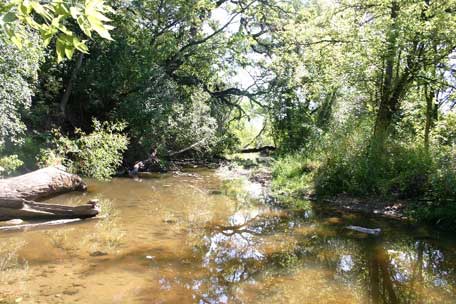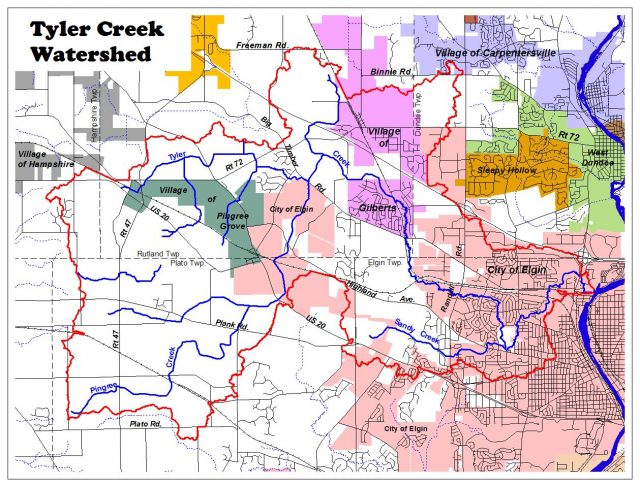By Carl Missele, Treasurer TCWC
The Tyler Creek Watershed Coalition (TCWC) was formed to initiate and manage the green infrastructure recommendations that came from the Tyler Creek Watershed Plan (TCWP). The TCWP was prepared utilizing funding from the U.S. Environmental Protection Agency, Section 319 of the Clean Water Act. The TCWP was completed in 1996 and revised in 2008. The main goals of the TCWP are stormwater management and pollution prevention.
Tyler Creek Eats its Banks!
Since the formation of the TCWC it has been mainly reactive to the problems that arise in the watershed. But the coalition has been effective in remediating several creek bank erosion problems using money from the Tyler Creek Fund (TCF). The TCF was created in 1986 by the City of Elgin. The money in the fund came from homebuilders and grants. The TCF was to be used for regional stormwater control by damming Tyler Creek west of the City. Regional stormwater control would free the homebuilders from doing local storm water management through the creation of retention ponds, thus giving them more usable land area to build houses. The City was unable to get permits from the Army Corps of Engineers to proceed with the creek damming plan. That money was then earmarked for only those projects in the Tyler Creek Watershed within the City of Elgin.
The TCWC has worked with residents who live on Tyler Creek and who are losing their properties due to creek bank erosion. In the past several years the coalition has helped 10 residents, a Home Owners Association, and Judson University by connecting those who need help with project planning, implementation, and funding. The TCWC is the advocate for those in need of help to get the funding for their projects. The TCWC writes the justification for the projects and then works with the Finance and Legal Departments at the City of Elgin to use money from the TCF. Upon approval of the projects, the City uses the TCF to cover half the cost of the projects and provides loans for the other half. The 10 year loans come with no interest for the first three years and at the prime rate for the remaining years.
In 2016 the coalition started a project for the Garden Quarter Townhouse Association. One of the townhouses, close to Tyler Creek, was in danger of losing its stability due to creek bank erosion. The coalition was able to help them get a project plan, a quote for the project, and funding. Due to several minor problems, the funding was delayed until 2017 but $43,000 was approved for the project.
Dirty Water
Pollution of the creek comes from many sources. Creek bank erosion causes silt to be carried to places where it damages habitat. Chemical contamination from cars, trucks, roads, and parking lots comes as a result of runoff where the storm water goes directly into the nearest stream. Runoff from residences often contains chemical contaminants such as lawn fertilizers and pesticides. Damage to the creek also comes from residents who use the creek as their personal dump. Paint, oil, grass clippings and yard waste are thrown into the creek and sometimes into storm basins. These people need to be educated about how these things affect the flora and fauna that live in and around the creek. So in 2016, the TCWC developed a PowerPoint presentation that addresses these problems and promotes proper ways to deal with them.
Thirty Six Inches a Year
Stormwater management is challenging in a community that was founded in 1835 and incorporated in 1854 when there were no guidelines or rules for managing stormwater. As the community grew, stormwater was directed into the nearest river or creek. When that was not possible, it was directed most often into existing sanitary sewer systems. Once Elgin was built out on both sides of the Fox River, it was too late to go back and create stormwater storage in the established community. Since large scale storage of stormwater is not possible in the older parts of Elgin, small scale projects must be considered. That is best done by keeping stormwater from leaving one’s property. Doing that helps in two ways. One, it keeps lawn fertilizers and pesticides from leaving the property and two; it reduces the quantity of water entering our streams and in some cases, our sanitary sewers. The PowerPoint presentation that the Coalition created addresses those problems and offers possible solutions.
Dam!
In the last five years, two dams on Tyler Creek have been removed. One was in Wing Park and the other was on the Judson University campus. One more dam, or weir, remains on the South Branch of Tyler Creek. The weir was constructed in 1994 to create a retention pond that would also be an amenity for the residents of the residents of Lincolnwood Terrace. The pond, 15 feet deep at its center, filled with silt in less than one year! Though it was dredged to remove the silt, it filled again in less than a year. Today, the pond is less than one foot deep, with several silt islands, and is quite unattractive. Removing that weir would clear Tyler Creek of all dams within the City of Elgin. The TCWC is working with the Elgin’s Engineering Department and the Homeowners Association (HOA) of Lincolnwood Terrace to develop a plan for removing the weir. The plan will explore funding sources, will address the control of possible pollution to downstream areas, and show how to make the completed project attractive and affordable for the residents of the HOA.

The challenges for the TCWC are many but financing the projects outlined in the Tyler Creek Watershed Plan is probably the biggest challenge. Close behind is the challenge of managing the projects once they are chosen as important. Both can be full time jobs, but the TCWC is composed of unpaid dedicated volunteers who have managed to guide major projects to completion. These accomplishments are a tribute to the dedication of our volunteers.

